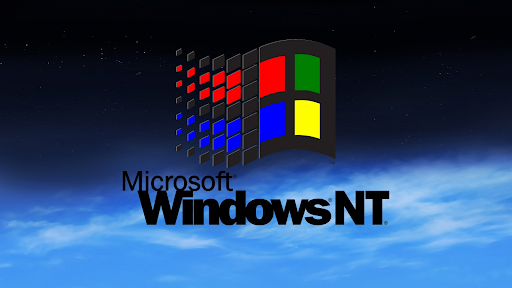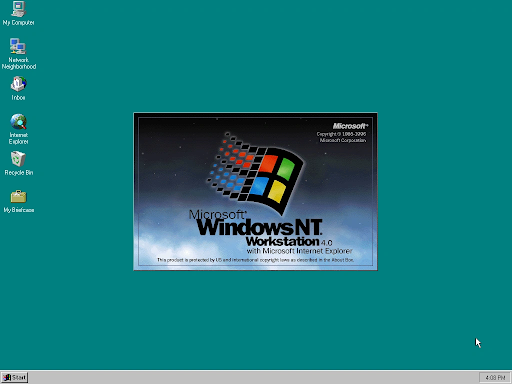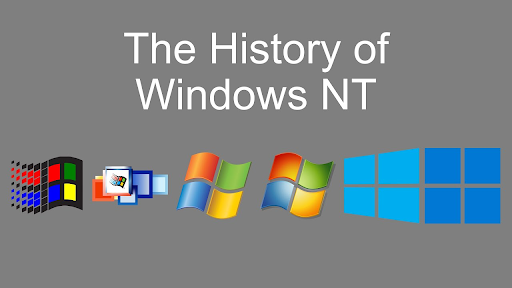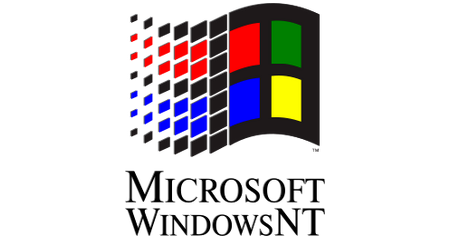Windows NT is Microsoft's proprietary graphical operating system, released on July 27, 1993. It's the basic architecture for all Windows operating systems.
Since its release, Windows has had many designs and versions, including Windows 1, Windows NT, Windows 2000, Windows 10, and now Windows 11.
The first Windows release was Windows 1 in 1985. After years and a series of Windows releases, Microsoft released Windows NT, a business-orientated operating system.
At its release, few understood it, and even now, more are yet to understand Windows NT.
So, what’s Windows NT, what’s it used for? And is Windows NT the same as Windows 2000?
Let’s find out what Windows NT is and more!
What is Windows NT?

Microsoft Windows NT (Windows New Technology) is a Windows personal operating system designed for users and companies that need advanced functions. It is a processor-independent, multiprocessing, and multi-user operating system for business and personal computers.
The first version of Windows NT (WinNT) was released on July 27, 1993, as Windows NT 3.1. available in client and server versions. It included built-in networking and preemptive multitasking. In 1996, NT Version 4.0 switched to the Windows 95 desktop.
"NT" in WinNT was originally an acronym for "New Technology." But it no longer carries any specific meaning. Also, starting with Windows 2000, "NT" was removed from Windows product names and is only included in the product version string.
What does Windows NT Means, and what does it do?
Windows NT is described as a family of Microsoft operating systems. This is why it’s a processor-independent, multiprocessing, and multi-user operating system.
Also, Windows NT is actually two products (or designed to complement 2 Windows designs): Workstation and Windows Server.
- Microsoft NT Workstation. For users, especially businesses, needing faster PC performance and a fail-safe system than Windows 98 and 95.
- Microsoft NT Server. For business machines/PCs that need to provide server services for network-attached computers. The Server is required, together with an Internet server such as Microsoft's Internet Information Server (IIS), for a Windows system that plans to serve Web pages.
Windows NT Workstation was designed to complement workstation (consumer) versions of Windows that were based on MS-DOS (including Windows 1.0 through Windows 3.1x).
Windows NT Main Features: Summary

As a personal computer operating system, and a family of operating systems, here’s a summary of the various Windows NT features:
- Multi-boot capability, allowing Windows NT to coexist with other operating systems.
- NT supports the 32-bit version (x86 machines) of Windows. Unlike Windows CE, which ran on various processors, nearly all NT deployments were on x86 architecture.
- Windows NT 3.1 runs on Intel IA-32 x86, DEC Alpha, and MIPS R4000 processors and 3.51 added support for PowerPC processors.
- Preemptive multitasking and multithreading operations. This is why NT wasn’t favored initially for use with slower processors with less memory.
- Supports multiple CPU systems with SMP (Symmetric Multiprocessing technology).
- Supports various hardware platforms such as CISI (Intel system) and RISC (such as Power PC, R400, etc.).
- Interoperable with various network operating systems such as UNIX, Novell Netware, Macintosh, and more.
- Provides extensive support for customer operating systems, such as MS-DOS, Windows, Windows NT Workstation, UINX, OS/2, Macintosh, etc.
- NT supports multiple protocols: TCP / IP, NetBEUI, DLC, AppleTalk, NWLINK, etc.
Windows NT Supported Platforms
At first, Windows NT was for x86 machines only.
Windows NT was the first 32-bit version of Windows. Its previous consumer-oriented counterparts, Windows 3.1x and Windows 9x, were 16-bit/32-bit hybrids.
NT ran 16-bit DOS and Windows apps in its own emulation mode and provided a command processor that executed DOS commands.
Unlike the previous Windows 95/98, Windows NT supported multiprocessing, added security and administrative features, and incorporated dual boot. Designed for business/enterprise use, each application could access 2GB of virtual memory.
On design, Windows NT promised to run on everything. So, Microsoft included broad software compatibility through the support of several API "personalities," namely, Windows API, POSIX API, and OS/2 API. Microsoft also added MS-DOS compatibility through a DOS virtual machine. Similarly, integrating a chat API in modern applications ensures seamless communication across different platforms and systems. In general, Windows NT supported the following processor architectures:
- MIPS
- ARM
- IA-32
- PowerPC
- DEC Alpha
- X86-64
- Itanium
NT for MIPS and PowerPC were planned but dropped, while support for Alpha servers reached the beta stage.
Windows NT did not support Plug and Play, which Microsoft later added in Windows 2000 and XP (both based on the NT core technology).
Windows NT family was gradually expanded into Microsoft's general-purpose operating system product line for all personal computers, deprecating the Windows 9x family.
Windows NT Releases

The technology of Windows NT is the foundation of Microsoft’s operating system Windows 2000, and succeeding operating systems.
| Name | Release Date | Editions |
|---|---|---|
| NT3.1 = Windows NT 3.1 | July 27, 1993 | Workstation (Windows NT) and Advanced Server |
| NT 3.5 = Windows NT 3.5 | September 21, 1994 | Workstation, Server |
| NT 3.51 = Windows NT 3.51 | May 30, 1995 | Workstation, Server |
| NT 4.0 = Windows NT 4.0 | July 29, 1996 | Workstation, Server, Server Enterprise Edition, Terminal Server, Embedded |
| NT 5.0 = Windows 2000, Windows 2000 x64 |
February 17, 2000 |
Professional, Server, Advanced Server, Datacenter Server, Media Center, Starter, Embedded |
| NT 5.1 = Windows XP | October 25, 2001 | Home, Professional, IA64, Media Center (2002, 2003, 2004 & 2005), Tablet PC, Starter, Embedded, N |
| NT 5.2 = Windows Server 2003 and XP x64 edition | April 24, 2003, April 25, 2005 | Standard, Enterprise, Datacenter, Web, Small Business Server; Professional x64 Edition |
| NT 6.0 = Windows Vista | Business: November 2006; Consumer: January 2007 | Starter, Home Basic, Home Premium, Business, Enterprise, Ultimate |
| NT 6.0+ = Windows Server "Longhorn" (codename, Windows Server 2008 | 2007 | Foundation, Standard, Enterprise, Datacenter, Web Server, HPC Server, Itanium-Based Systems |
| NT 6.1 = Windows 7 | October 22, 2009 | Professional, Home Premium, Ultimate |
| NT 6.1 = Windows Server 2008 R2 | October 22, 2009 | Foundation, Standard, Enterprise, Datacenter, Web Server, HPC Server, Itanium-Based Systems |
| NT 6.2 = Windows 8 | October 26, 2012 | Home, Pro, Enterprise, RT |
| NT 6.2 = Windows Server 2012 | September 4, 2012 | Foundation, Essentials, Standard, Datacenter |
|
NT 6.3 = Windows 8.1
|
October 17, 2013 | Home, Pro, Enterprise, RT 8.1 |
| NT 6.3 = Windows Server 2012 R2 | October 17, 2013 | Foundation, Essentials, Standard, Datacenter |
| NT 10.0 = Windows 10 | July 29, 2015 | Home, Pro, Pro Education, Enterprise, Education, Windows 10 S, IoT Core, Mobile, Mobile Enterprise |
| NT 10.0: Window Server 2016 | October 12, 2016 | Essentials, Standard, Datacenter, Multipoint Premium Server, Storage Server, Hyper-V Server |
| NT 10.0: Window Server 2019 | October 2, 2018 | Essentials, Standard, Datacenter |
| NT 10.0: Windows Server 2022 | August 18, 2021 | Essentials, Standard, Datacenter |
| NT 10.0 = Windows 11 | October 5, 2021 | Home, Pro, Education, Enterprise |
Windows Hardware requirements
Windows NT is a family of operating systems. So, the minimum hardware specification required may differ based on each NT version release.
|
NT Version |
CPU |
RAM |
Disk space |
|
NT Workstation 3.51 |
386, 25 MHz |
8 MB |
90 MB |
|
NT 4.0 Workstation (Intel) |
486, 33 MHz |
12 MB (16MB) |
110 MB |
|
2000 Professional |
Pentium, 133 MHz |
32 MB |
650 MB |
|
Windows Vista |
Pentium III, 800 MHz (Home Basic) 1GHz (others) |
512 MB (Home Basic) 1GB (other editions) |
15 GB (Home Basic) 40GB (others) |
|
Windows 7 |
1 GHz |
1GB (32-bit) 2GB (64-bit) |
16GB (32-bit) 20GB (64-bit) |
|
Windows 8 & Windows 8.1 |
1 GHz with NX bit, SSE2, PAE |
1GB (32-bit) 2GB (64-bit) |
16GB (32-bit) 20GB (64-bit) |
|
Windows 10 |
1 GHz with NX bit, SSE2, PAE |
1GB (32-bit) 2GB (64-bit) |
16GB (32-bit) 20GB (64-bit) |
|
Windows 11 |
1GHz with 2 or more cores on a compatible 64-bit or SoC |
4GB (64-bit) |
64 GB or larger (64-bit) |
Windows NT vs Windows 2000
The technology of Windows NT was the foundation of Windows 2000 and succeeding Microsoft operating systems.
During the release, Microsoft released four editions of Windows 2000:
- Professional
- Server
- Advanced Server
- Datacenter Server
Three editions were later added: Media Center, Starter, and Embedded.
While each Windows 2000 edition targeted a different market, they shared core features, including system utilities like Microsoft Management Console and system administration applications.
Essentially, Windows 2000 was released as an automatic update to Windows NT 4.0, not an upgrade to Windows 98 or 98SE.
So, Windows 2000 (or Windows NT 5.0) was a continuation of the Microsoft Windows NT family of operating systems. It was released on February 17, 2000 and replaced Windows NT 4.0.
Windows 2000, built on Windows NT, offered more improvements, including:
- Support for full 32-bit operating system
- Support for NTFS or FAT32, with support for hard disk drives as big as 32GB when running FAT32. Actually, Windows 2000 introduced NTFS 3.0., Encrypting File System (EFS), and basic and dynamic disk storage.
- Increased support for different languages and disabilities through assistive technology.
- Introduced Windows File Protection, preventing installed apps/programs from deleting necessary system files
- Eliminated many reboot scenarios, including program installations that require a reboot to function correctly
- Support for up to 4GB RAM
- Microsoft Management Console (MMC)
- Stronger Internet integration with Internet Explorer 5.0.1
- Windows 2000 Server family introduced Active Directory, which in the years following became a widely used directory service in many business environments.
During its release, Microsoft marketed Windows 2000 as the most secure Windows version ever. And Windows 2000 was Microsoft's business operating system until the release/introduction of Windows XP Professional in 2001.
Windows 2000 and Windows 2000 Server were succeeded by Windows XP and Windows Server 2003, released in 2001 and 2003, respectively.
Later, Windows XP became Microsoft's minimum-supported OS for most Windows programs until Windows 7 replaced it, whose support ended on January 14, 2020. Read Windows 7 end of life.
The current minimum-supported Microsoft OS is Windows 10, whose support is scheduled to end in 2025. Read Windows 10 end of life.
Also, Windows 2000 is the final Windows version that supported PC-98, i486, SGI Visual Workstation 320 and 540, Alpha, MIPS, and PowerPC in alpha, beta, and release.
Its successor, Windows XP, required a processor in any supported architecture (IA-32 for 32-bit CPUs and x86-64 and Itanium for 64-bit CPUs).
Now all Windows operating systems, including Windows 11, are based on Windows 2000 architecture. But each release has its improved features and capabilities.
Is Windows NT the same as Windows 10?

No.
Windows NT is a family of Windows operating systems from 1993 that includes Windows 2000, Vista, 7, 8, 8.1, Windows 10, and now Windows 11.
Windows 10 is Windows NT 10.0.
Windows NT is a family of operating systems developed by Microsoft that features multi-processing capabilities, processor independence, and multi-user support. Windows NT was the predecessor to Windows 2000.
Even though "NT" is no longer part of the marketing names, all current Windows versions still use the exact same NT system architecture (distinctly different from Windows 95/98/ME). Internally, Windows 2000 calls itself "NT 5.0" as it is a direct descendant of Windows NT 4, while the Vista-Win10 series is "NT 6.x".
The first version was released in 1993 as Windows NT 3.1, produced for servers and workstations. It was intended to complement the consumer versions of the MS-DOS-based Windows operating system that Microsoft released (from Windows 1.0 to 3.1x).
Conclusion
That’s it: Windows NT is the proprietary graphical operating system produced by Microsoft and released on July 27, 1993.
It is the basic architecture of Windows 2000 and all current versions of Windows operating systems.
We’re glad you’re read this article up to here :) Thank you :)
Contact us for more information if you have any questions or concerns about Windows NT or other Windows OS releases.
In the meantime, read our Blog for more great articles like this one! In addition, you can check our Help Center for a wealth of information on how to troubleshoot various issues.
One more thing …
If you have an extra minute, please share this article with your friends or on your socials. Someone else may also benefit.
And, subscribe to our newsletter to get early access to our blog posts, promotions, and discount codes.
Windows NT FAQ
What is Windows NT features?
The three key features of Windows NT are as follows:-
- It is a multitasking, multi-user, and multithreading operating system.
- It also supports a virtual memory management system to allow multiprogramming.
- Symmetric multiprocessing allows it to schedule various tasks on any CPU in a multiprocessor system.
What was used before Windows NT?
Before Windows NT, Microsoft released Windows 3. x, Windows 95, and Windows 98 platforms.
Is Windows NT and 2000 same?
Yes and No. Windows NT is a Microsoft Windows personal computer operating system designed for users and businesses needing advanced capability. NT's technology is the base for the Microsoft successor operating system, Windows 2000.
Is Windows 10 based on NT?
The OS variable WindowsNT is okay since Windows 10 Kernel is based on NT.
Is Windows NT still in use?
The NT version number is not now generally used for marketing purposes. But it’s still used internally and said to reflect the degree of changes to the operating system's core.
Does Windows 11 run on NT?
Windows 11 is the latest major release of Microsoft's Windows NT operating system. It was released in October 2021. Microsoft released Windows 11 as a free upgrade to its predecessor, Windows 10 (2015), available for any Windows 10 devices that meet the new Windows 11 system requirements.
Keep Learning
» What Happens if You Install Windows 11 on Unsupported Hardware?
» What Happens if You Don’t Activate Windows 10?
» How To Fix the “This PC Can’t Run Windows 11” Error
» How to Upgrade Your Windows 7, 8 or 8.1 OS to Windows 10
» How To Fix Windows 10 Update Status Stuck on Pending
